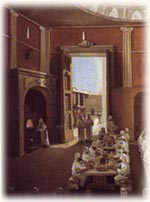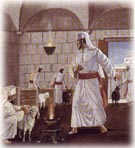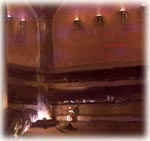The largest building in the Azarah was the Heichal,
which will be discussed later. The second largest was the Hearth. This
dome-covered structure was the sleeping quarters for the priests who
performed the services.
Most authorities say that it was half inside the Azarah and half outside. It had four rooms connected with the structure.
Some say that the side rooms were outside the building.
Others say that the four side rooms were inside the building, one room
in each corner.
The Hearth itself served as a dormitory. The walls were
lined with great stone steps. Some sources say the priests slept on
these steps, while others maintain that the sleeping quarters were built
into the wall, like cubicles or coops.
 The
priests would climb the steps to their respective cubicles, the elder
priests slept above, and the younger ones slept on the floor.
The
priests would climb the steps to their respective cubicles, the elder
priests slept above, and the younger ones slept on the floor.
In the middle of the floor was a tile one cubit by one
cubit. It could be raised by lifting a hoop set into it. Underneath was a
chain, to which were attached the keys to the gates.
One of the priestly officials would take the keys after
the Temple doors were locked at night, place them on the chain, and
sleep atop the tile.
* * *
Four rooms were connected to the Hearth:
lishkat Lechem Hapanim - Chamber of the Showbread
 The twelve "showbreads" used for the Shulchan were baked here every Friday. On Shabbat the new showbreads replaced the older ones which were later eaten by the Kohanim in this room.
The twelve "showbreads" used for the Shulchan were baked here every Friday. On Shabbat the new showbreads replaced the older ones which were later eaten by the Kohanim in this room.
lishkat HaChosamot - The Receipt Chamber
When one needed oil, wine, or flour for his sacrifice, he purchased special tokens ("receipts") in this chamber. With these tokens he would pick up his order from the chamber of oils.
This room also contained the stones of the Mizbe'ach defiled by the Greeks.
When one needed oil, wine, or flour for his sacrifice, he purchased special tokens ("receipts") in this chamber. With these tokens he would pick up his order from the chamber of oils.
This room also contained the stones of the Mizbe'ach defiled by the Greeks.
 lishkat Hatela'im - The Sheep Chamber
lishkat Hatela'im - The Sheep ChamberThis chamber was used as a barn for the sheep offered as "daily sacrifices". The sheep were checked for blemishes and imperfections twice a day, for a four-day period prior to being sacrificed
lishkat Bet Hamoked - the Hearth Chamber
This was a chamber that led to another hearth underground used by Kohanim who were not ritually pure. A Mikvah (ritual bath) and restrooms were also located in this underground chamber.
Other Gates leading to the Northern side of the temple included the Sha'ar Hanitzutz - Gate of Sparks and the Sha'ar Hanashim - The Women's Gate.
In front of this gate was a small courtyard surrounded
by columns, which supported a balcony upon which kohanim from the
priestly guard stayed watch at night.
The sun's rays shining between the columns appeared to be flickering sparks, giving the gate its name.
The gate was also called Gate of Yoachim, because it was from this very spot that King Yoachim was led into exile by Nebuchadnezzar.
Women were required to bring a sacrifice after giving
birth, and on other occasions. They would stand in this gateway while
their sacrifice was being offered. This gateway was narrower than the
other gates on the north side.

No comments:
Post a Comment